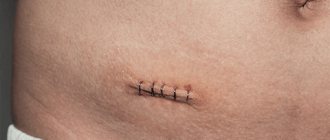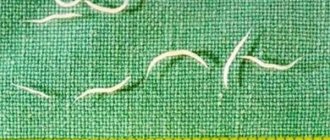Description
Amenorrhea (ICD 10 N91) is not a disease, but a condition of the body, which is characterized by the absence of menstruation for a long time.
This problem occurs due to a malfunction of the woman’s reproductive system or the presence of defects in the structure of the reproductive organs. Forms of amenorrhea:
- true;
- false;
- primary;
- physiological;
- secondary;
- pathological
Amenorrhea can be caused by pathological changes in the uterus, ovaries or fallopian tubes, so if characteristic symptoms appear, you should definitely consult a gynecologist. He must conduct a full examination of the body to understand what causes the disease. Correct diagnosis helps to eliminate serious problems in the functioning of a woman’s reproductive system.
Depending on the severity of the condition, the following stages of amenorrhea are determined:
- 1st degree amenorrhea – absence of menstrual flow for less than a year;
- amenorrhea 2 degrees - when there is no menstruation from 1 to 3 years;
- 3rd degree amenorrhea is a disruption of the natural process in women for 3 years or more.
Chronic amenorrhea can bother a woman for many years. This condition is quite dangerous.
Primary amenorrhea
Primary amenorrhea is characterized by a condition when a girl does not menstruate during adolescence, which occurs due to abnormal development of the genital organs. In this case, girls may experience a fusion of the vaginal canal or hymen, which is corrected through surgery.
Amenorrhea in adolescents can occur due to retarded physical development and a severe psycho-emotional state. A provoking factor may be a debilitating diet or significant physical activity.
The appearance of amenorrhea syndrome in adolescents may be a hereditary factor when the girl’s mother also began menstruation at the age of 17-19.
Sometimes the cause of early amenorrhea can be dangerous diseases that are accompanied by developmental abnormalities.
Secondary amenorrhea
Secondary amenorrhea is characterized by the disappearance of menstruation when a woman’s monthly cycle was already established. It can occur at any age and negatively affects reproductive function.
Causes of secondary amenorrhea:
- hormone imbalance;
- gynecological diseases (sometimes amenorrhea is caused by fibroids);
- psycho-emotional state of a woman;
- exhaustion of the body and other factors.
Depending on the causes of amenorrhea, it is necessary to use certain treatment methods that are aimed at normalizing menstruation.
Classification of secondary amenorrhea:
- hypogonadotropic amenorrhea - occurs due to a decrease in the concentration of gonadotropic hormones secreted by the pituitary gland;
- hypothalamic amenorrhea - this condition appears as a result of a negative effect on the body or damage to the central nervous system;
- pituitary amenorrhea – when the adenohypophysis is damaged or its blood supply is impaired;
- ovarian amenorrhea - caused by inflammatory processes in the ovaries or dysfunction of this organ;
- amenorrhea of central origin - accompanied by disturbances in the functioning of subcortical structures and the brain;
- uterine amenorrhea - appears due to diseases that affect the uterus.
Treatment of secondary amenorrhea should be carried out under the supervision of an experienced obstetrician-gynecologist.
Functional hypothalamic amenorrhea - features
In gynecology, amenorrhea is often encountered, which is caused by changes in the hypothalamus, as a result of which its secretion decreases. When treating a disease, it is necessary to eliminate the main negative factors that caused this condition. These are neuroinfections, psychological factors, intoxication, difficult childbirth. Functional amenorrhea after discontinuation of contraceptives occurs in 5-8% of women.
The causes of amenorrhea and the necessary treatment are determined after a comprehensive examination of the patient, which is carried out by a gynecologist.
Psychogenic amenorrhea
Psychological causes of amenorrhea occur in many women who have identified symptoms of the disease. It is caused by prolonged stress, nervous strain, and constant lack of sleep.
Military amenorrhea is a type of this pathological condition. It has been noticed that in women who are in a military situation, reproductive functions are suspended.
Psychosomatics and amenorrhea are interconnected: psychological problems directly affect the reproductive processes in the female body.
Lactational amenorrhea
Lactational amenorrhea occurs during breastfeeding. A woman's body produces hormones that suppress ovulation. Lactational amenorrhea, which lasts from 2-3 months to a year, is considered normal.
Postpartum amenorrhea does not pose a danger to a woman’s body. In this case, specific treatment is not carried out, because after the end of feeding, menstruation should be restored.
Physiological amenorrhea
Natural amenorrhea occurs during pregnancy or after menopause. Pre-teen girls also do not menstruate. This is considered a normal physiological process that does not require additional intervention or treatment.
Hormonal amenorrhea
The causes of such amenorrhea may be malfunctions of the endocrine system, which sometimes occur due to:
- obesity;
- chronic stress;
- exhausting diets;
- significant physical activity.
Amenorrhea and sports are frequent companions. With strong physical exertion, the functioning of the pituitary gland, thyroid gland, and ovaries is disrupted. With anorexia, amenorrhea is also not uncommon. When these factors are eliminated, menstrual function normalizes.
Amenorrhea – hypomenstrual syndrome
Main varieties:
- dysmenorrhea – amenorrhea and a pathological condition of a woman, which is characterized by severe pain during menstruation;
- oligomenorrhea – amenorrhea, which is manifested by short menstruation of 1-2 days;
- opsomenorea – menstruation after 6-9 weeks;
- spaniomenorrhea – the number of menstruation is reduced to 2-3 times a year.
Dysmenorrhea is secondary amenorrhea that occurs in women after 30 years of age. It may appear due to the appearance of inflammatory processes in the pelvis.
Is it possible to get pregnant with amenorrhea?
Sick women have a question: is it possible to get pregnant with amenorrhea? This process in most cases is characterized by the absence of ovulation, so pregnancy is impossible with amenorrhea.
To help a woman, a gynecologist must conduct research and prescribe treatment. After taking hormonal contraceptives, amenorrhea can be neutralized, and reproductive function is restored over time. This treatment regimen is often used by many gynecologists.
Amenorrhea - consequences
Amenorrhea that lasts a year or less can cause serious problems with the reproductive system. This condition can cause irreversible changes in the ovaries and uterus.
Amenorrhea is the leading cause of infertility among women of all ages. With this disease, after some time the opportunity to restore reproductive function disappears, especially if this condition arose in adolescence.
When is amenorrhea normal?
- Age before puberty
Usually, menstruation begins at the age of 12-16 years; before the age of 12-13 years, the absence of menstruation is the absolute norm.
- Menopause
The normal age of menopause is 49-52 years. These are very average figures; we need to focus on the age of menopause among women in the family.
- Lactation
The absence of menstruation during breastfeeding is lactational amenorrhea. This is the time of lactational amenorrhea, a completely special balance of hormones, high levels of prolactin and eggs do not mature. But we do not recommend it as a method of contraception, since it is enough to take a break in feeding for more than two hours and some egg may mature. And if sex life is regular, then you may not see your period, but get pregnant right away.
- Pregnancy
The absence of menstruation during pregnancy is natural. The function of the egg is completed, you are carrying a baby, no other eggs are needed yet.
Symptoms
Photo: cloudstatic.eva.ru
The main symptom of amenorrhea is the complete absence of the menstrual cycle. Girls often complain about excess weight, which is associated with hormonal imbalance in the body. Pain during amenorrhea may occur due to ovarian dysfunction.
In addition, representatives of the fair sex are diagnosed with increased testosterone levels. They complain of the following symptoms:
- increased sweating;
- rapid weight gain;
- intensive hair growth;
- the voice becomes rougher.
With secondary amenorrhea, doctors note the appearance of galactorrhea. Girls who are not pregnant begin to secrete milk. If the level of prolactin in the body increases, then doctors diagnose “secondary amenorrhea”.
Women who have not yet entered menopause experience unpleasant symptoms of menopause. They experience frequent and regular hot flashes, heart pain, and excessive sweating.
Symptoms of amenorrhea are accompanied by headaches, general weakness, fatigue, drowsiness and irritability. The absence of menstruation during amenorrhea is a signal to consult a doctor. If menstruation is not observed for three months, then it is necessary to perform a thorough diagnosis and eliminate the main cause of the failure.
Symptoms of hypothalamic amenorrhea
The causes of amenorrhea are very diverse, so after the first symptoms appear, you need to consult a doctor to eliminate the causative agent of the disease. The most common reason is the presence of various hormonal imbalances. When normal functioning of the hypothalamus is observed in a woman’s body, it secretes all the necessary substances to stimulate the pituitary gland. This organ affects the functioning of the ovaries, stimulating the normal cycle of egg maturation.
If the fair sex has problems with the endocrine system, then they may encounter the following problems:
- The influence and regulation of the normal functioning of the hypothalamus is reduced.
- The amount of hormones in the body changes.
- There is an imbalance of thyroid hormone. Its insufficient or excessive amount leads to various disorders in the menstrual cycle. Girls may notice the following symptoms: decreased frequency and irregularity of menstruation.
- The functioning of the adrenal glands is disrupted, because in the fair sex the content of the male hormone in the body increases.
Symptoms of hypothalamic amenorrhea are associated with the origin and duration of the disease. In most cases, the disease develops with regular intense exercise, frequent stressful situations, poor diet and rapid weight loss.
The main symptoms are absence of menstruation, weight gain, lack of pubic and armpit hair, increased blood pressure and osteoporosis.
Primary amenorrhea without delay in the development of secondary sexual characteristics
In this group of conditions, gynathresia and aplasia of the uterus are most common.
Gynatresia is a fusion of part of the vagina or a complete fusion of the hymen (hymen). This also forms in utero, but fortunately it can be corrected quite well surgically. Usually, in this case, the ovaries function fully, but there is nowhere for menstrual blood to flow. After surgery, both a normal menstrual cycle and pregnancy are quite possible.
Uterine aplasia is the congenital absence of the uterus. Often combined with vaginal underdevelopment and defects of the kidneys and urinary tract. The ovaries most often work normally, the hormonal profile is also normal. But the uterus is a small dense formation without a cavity inside, or is not defined at all. In this case, the menstrual cycle and pregnancy are impossible. But after surgical correction, sexual life has no significant restrictions.
Many of the listed pathologies are the result of intrauterine mutations and are already observed in adolescents. Therefore, medical interventions most often help a girl adapt to her body and live a full life. But congenital conditions cannot be completely cured.
Diagnostics
Photo: islamnews.ru
Diagnosis of primary amenorrhea
- Anamnesis collection. To make a diagnosis of amenorrhea, it is necessary to carefully analyze the girl’s medical history, including family history. Perhaps late menarche is an inheritance from mother, grandmother, and other relatives. It is necessary to collect information about the girl’s sexual development, the operations she has undergone, find out when secondary sexual characteristics appeared, whether the girl adheres to any diet, or whether she is involved in “non-female” sports.
- General inspection. The doctor pays attention to physique, height, the presence of hypertrichosis (excessive body hair growth), and the development of the mammary glands.
- Examination in a gynecological chair. It is carried out to exclude defects of the genital organs - androgenital syndrome and gonadal dysgenesis.
- Ultrasound of the pelvic organs. Check for polycystic ovary syndrome.
- MRI of the brain and pituitary-hypothalamic study. To identify or exclude pathologies of pituitary gland development.
- Karyotyping. A method that allows you to detect or exclude a number of genetic pathologies.
Diagnosis of secondary amenorrhea
The condition is detected in several ways:
- Examination in a gynecological chair. When diagnosing amenorrhea, pregnancy should be excluded. By asking, it is determined whether the cause of amenorrhea is diet, physical overload or stress. Exclude genetic predisposition.
- Tests for amenorrhea: plasma prolactin levels. It should not exceed 20 ng/ml. If there is too much prolactin, the pituitary gland should be examined;
- on the level of FSH (follicle-stimulating hormone). It is increased when the gonads are underdeveloped, decreased when the pituitary gland is insufficient;
- on the level of LH - luteinizing hormone. If the indicator is too high and FSH is below average, this is evidence of polycystic ovaries.
- measurement of the density of thyroid hormone accumulation: T4 and TSH (thyroxine and thyroid-stimulating hormone);
- Glucose tolerance tests, glucose level measurement.
- progesterone test. If the test is negative, the cause of amenorrhea is the effect of hormones on the endometrium or its changes for another reason. If positive, bleeding occurs during anovulation with preserved estrogen secretion.
You can avoid the appearance of amenorrhea by adhering to the principles of a healthy diet, the correct way out of stressful situations, maintaining a normal weight, regular sex life, and systematic visits to the gynecologist.
Menstrual cycle disorders
If a woman experiences certain deviations from the cycle features described above, then in this case menstrual dysfunction occurs. Experts define two groups of such disorders: hypomenstrual syndrome and hypermenstrual syndrome . Such violations occur under the influence of many factors. These are, first of all, diseases and mental disorders, severe emotional shocks, neurological diseases, obesity , infectious diseases, cardiovascular diseases, and the influence of occupational factors. Menstrual dysfunction is also possible as a consequence of genetic diseases, hormonal imbalance, gynecological operations and some other factors. Sometimes several reasons are combined that provoke menstruation irregularities.
Treatment
Photo: opt-611422.ssl.1c-bitrix-cdn.ru
Amenorrhea is a complex disease, so its treatment is usually lengthy and varied. The treatment tactics for this pathology should be selected by a gynecologist depending on the cause of the disease.
So, if the cause of the disease is infantilism of the reproductive system, then the emphasis in treatment is on a special diet and taking hormonal drugs. This leads to the woman rapidly gaining the missing fat and muscle tissue over the course of several months.
If amenorrhea is caused by developmental defects, doctors may prescribe surgical treatment.
If a woman has a secondary form of the disease, treatment of amenorrhea must necessarily include eliminating the cause that caused it. This often requires changing your diet or avoiding stressful situations.
For ovarian pathologies, doctors prescribe hormone replacement therapy. It is carried out only under the careful supervision of a specialist. During the entire treatment period, a woman should undergo hormone tests from time to time.
All types of amenorrhea, regardless of the reasons that caused it, require treatment. The only exception in this case may be lactational amenorrhea, since six months after childbirth the menstrual cycle begins to improve. Until this time, a woman can use the lactational amenorrhea method (if used correctly, its reliability can reach 98%).
In general, treatment for amenorrhea almost always includes:
- hydro- and physiotherapy;
- massage;
- physical therapy;
- performing hardening procedures;
- treatment with folk remedies;
- diet correction;
- taking vitamin and mineral complexes.
The best results are usually achieved by combining several treatment methods.
If a patient’s amenorrhea is a consequence of unfavorable psychogenic factors, doctors may additionally prescribe:
- psychotherapy sessions;
- oxygen therapy or yoga;
- general strengthening procedures.
It is worth noting that amenorrhea can only be cured by knowing the causes of its occurrence. And this can take a lot of time even for experienced doctors. That is why treating amenorrhea at home is unacceptable.
Homeopathy
Homeopathic medicines have a completely natural composition, but they are much more effective than conventional herbs. Doctors often prescribe them in addition to medications.
Treatment of amenorrhea with homeopathy is most often used if the disease was caused by chronic stress or severe emotional stress. For this purpose, homeopathic preparations with a sedative effect are used.
However, homeopathic remedies can be helpful for all types of amenorrhea. This is especially true for homeopathic remedies with hormonal effects. They bring the greatest benefit in the treatment of hypogonadotropic amenorrhea.
However, only a doctor should choose these drugs and prescribe their dosage based on the patient’s indications and contraindications.
Massage
Today, to eliminate the disease, many reputable doctors recommend that patients undergo massage for amenorrhea. The essence of this massage is to create vibrations in the area of the lumbar vertebrae. In this way, the nerve endings in this area are irritated, which ultimately has a stimulating effect on the reproductive organs.
Such a massage can help normalize menstrual function and ripen the genital organs.
To improve blood circulation in the pelvic organs, doctors may also perform tapping movements on either side of the lower spine.
Numerous positive reviews from patients about this procedure indicate its high effectiveness.
Diet
Diet for amenorrhea is of great importance. However, it should directly depend on the causes of the disease. So, if the cause of amenorrhea in a patient is fasting, then a high-calorie diet is indicated for her, and if the pathology is caused by Itsenko-Cushing's disease, the amount of food consumed, on the contrary, should be reduced.
However, no matter what the diet, nutrition during amenorrhea should always be complete, that is, a woman should not consume vitamins, fats, proteins, carbohydrates in quantities less than the daily norm.
With amenorrhea, it is very important to normalize the patient’s weight, since menstruation cannot proceed normally both with excess weight and with underweight.
To restore the functioning of the reproductive organs, it is also necessary to stop drinking alcohol and cigarettes, and normalize work and rest patterns.
Consulting and support
Women with amenorrhea should have adequate support from a gynecologist throughout the treatment process. For many women, hormone therapy is difficult; the condition increases the fear of remaining infertile or aging early. For this reason, the help of a doctor is the key to recovery and confidence that treatment can help restore regular periods.
A woman undergoing treatment for amenorrhea should visit the gynecologist strictly on schedule, without missing appointments and following all the doctor’s instructions.
ONLINE REGISTRATION at the DIANA clinic
You can sign up by calling the toll-free phone number 8-800-707-15-60 or filling out the contact form. In this case, we will contact you ourselves.
If you find an error, please select a piece of text and press Ctrl+Enter
Medicines
Photo: gripptips.ru
Treatment with drugs
Primary amenorrhea is most often treated with hormonal pills and a special diet that promotes weight gain through muscle mass. Vitamins for amenorrhea in the primary form are a mandatory form of treatment. In addition to special vitamin complexes for amenorrhea (vitamin E, vitamin B1 in solution, folic acid), it is recommended to introduce into the diet foods containing vitamin E, estrogen, folic acid, vitamins that provide significant assistance for amenorrhea.
Estrogen is found in:
- legumes;
- bran;
- apricots;
- coffee.
The following foods contain folic acid:
- spinach;
- salad;
- dark greens;
- celery;
- berries;
- peas;
- carrot;
- pumpkin;
- corn.
Vitamin E for amenorrhea is replenished by:
- sea fish;
- greenery;
- berries;
- porridge;
- nuts.
Taking vitamins during amenorrhea strengthens the nervous system and creates the prerequisites for restoring reproductive function naturally. Treatment of amenorrhea with vitamin preparations reduces nervous tension and improves tone. If this is the primary form, then pills for amenorrhea may not be needed, the function of the ovaries will recover on its own. Drugs for amenorrhea for girls are prescribed only in severe cases.
Vitamins, hormones, drugs (Folliculin, Cyclovita) and physical exercise eliminate health problems in teenage girls. Vitamin complex Cyclovita is a drug that replenishes the lack of minerals and vitamins and restores the tone of a weakened body.
Treatment with hormonal drugs is prescribed when a special diet and vitamin complexes do not help.
Primary amenorrhea caused by infectious diseases or intrauterine infections is treated with special medications.
In case of secondary type amenorrhea, in addition to hormones, they are treated with special diets, physiotherapy and vitamins necessary for patients of any age.
For secondary amenorrhea, specialists may prescribe the hormonal drug Duphaston. This is a progestogenic hormonal drug that includes dihydrogesterone. Duphaston is used for primary and secondary amenorrhea as hormone replacement therapy. Treatment of amenorrhea with Duphaston allows for effective therapy for patients of reproductive age.
Treatment of amenorrhea with Duphaston can be replaced with its analogue Utrozhestan. The drug is natural progesterone. Utrozhestan compensates for the deficiency of endogenous progesterone and replaces several drugs prescribed for the treatment of amenorrhea. Utrozhestan has no side effects and is quickly eliminated from the body.
Also, patients with amenorrhea are prescribed hormonal drugs to restore ovarian function in tablets.
Treatment of amenorrhea with replacement therapy drugs:
- Progestin drugs: Utrozhestan, Duphaston, Pregnin, Norkolut. For amenorrhea, these drugs are widely used to treat primary and secondary forms.
- Estrogens: Femoston, Femoston 210, Rigevidon.
- GnRH hormones: Cyclomate. Used to treat amenorrhea caused by polycystic ovary syndrome.
- Non-steroidal synthetic drugs: Clomiphene. These tablets stimulate ovarian function.
Cyclodinone (an analogue of Utrozhestan) is prescribed for amenorrhea to restore the cycle and prevent early menopause. Cyclodinone contains twig berry extract.
For amenorrhea, Femoston, like Cyclodinone, is used in case of insufficient hormone production.
Femoston helps restore the cycle against the background of stressful situations and sudden weight loss. It is prescribed to women after 40 years of age to delay early menopause, which is based on a deficiency of female sex hormones associated with women reaching a certain age. Femaston helps prevent hot flashes, emotional breakdowns, bone depletion, headaches, and dry mucous membranes.
Femoston lowers blood cholesterol levels, lowers LDL and increases HDL, prevents the risk of carcinogenesis and endometrial diseases.
Forecast
The prognosis for amenorrhea in women is favorable. The ability to become pregnant and bear a healthy child in the future depends on the type of menstrual irregularity, as well as the cause. With the development of essential primary amenorrhea, the prognosis regarding the restoration of the functional state of the woman’s reproductive system is questionable.
Since the pathological process is often accompanied by irreversible complications, in particular childhood infertility, the only way for a woman to conceive and bear a child is to use modern reproductive technologies. One of them is IVF - in vitro fertilization.
Polycystic ovary syndrome Menopause in women Hypothyroidism Thyrotoxicosis of the thyroid gland: what is it and how to treat it? Endometriosis Adenomyosis of the uterus
Folk remedies
Photo: itd3.mycdn.me
Treating amenorrhea with folk remedies is a common practice, but this approach is safe only in consultation with a doctor. This is necessary due to possible individual intolerance to medications.
Herbs for primary amenorrhea
It is impossible to induce menstruation with such a deviation using homeopathy, but improving hormonal levels and general well-being is a solvable task. Applicable:
- infusion of oregano. Has a calming effect;
- sage extract is a phytohormone with properties similar to female sex hormones.
Folk remedies in the case of primary amenorrhea usually provide only maintenance therapy; this form of the disease requires a more radical approach.
Folk remedies for secondary amenorrhea
Herbal treatment for this disease has a certain therapeutic effect. In order not to cause harm to the body, it is necessary to find out the cause of amenorrhea and consult a gynecologist.
The most common and effective means:
- hog uterus. Used in the form of an alcohol tincture or an aqueous solution, it is especially effective for hormonal disorders;
- taking a warm bath before bed with a decoction of mantle root;
- Oregano in the absence of menstruation is a means of restoring hormonal levels. The plant contains estrogens similar to those of women; an infusion of boiling water is used;
- According to many patients, elecampane promotes the rapid onset of menstruation during amenorrhea. The greatest results can be achieved with a delay of up to 10 days. They use the root of the plant, it is worth remembering that this is a very strong remedy, the dosage of the medicine must not be exceeded;
- olive oil mixed with viburnum berries;
- an infusion of onion peels (also according to reviews) relieves not only gynecological ailments, but also strengthens the body;
- to speed up the onset of critical days, grated citrus fruits are used - lemon or orange mixed with sugar;
- Parsley is one of the fastest-acting remedies, especially the juice of the plant. Both parsley stems and seeds are used. Finely chopped herbs are brewed in a thermos for about 12 hours. The seeds must be poured with warm boiled water and drunk in small sips;
- Hormel is a homeopathic medicine, it contains several plants that have a positive effect on the reproductive system during amenorrhea. Common columbine in the composition of the product is effective in the absence of menstruation, also has a calming effect and helps with sleep disorders;
- taking a bath with cocoa will not only speed up the onset of menstrual periods, but will calm and improve your mood;
- red brush shows the greatest activity when collected with hogweed and sage. When treating amenorrhea, such an infusion normalizes the functioning of the humoral and endocrine systems.
Under no circumstances should these medications be used if pregnancy is suspected; this can lead to serious complications and even death. In the absence of menstruation, be sure to do a rapid test and visit a doctor, and only then begin treatment for amenorrhea with folk remedies.
The information is for reference only and is not a guide to action. Do not self-medicate. At the first symptoms of the disease, consult a doctor.
Types of disease
In the international literature, pathology was assigned the ICD 10 code N91.0. The classification of this disorder is based on the reasons that caused the absence of menstruation for a long time. Types of amenorrhea require an individual approach and treatment. There are such main forms of the disease as:
- Primary amenorrhea due to the complete absence of menstruation by the age of 16. It can occur both with normally developed sexual characteristics according to age, and with deviations.
- Secondary amenorrhea after at least one ovulatory cycle with menstrual discharge from the vagina.
Also, the disease can be physiological and pathological. Physiological amenorrhea is caused by natural causes, goes away on its own and does not require special treatment. Pathological amenorrhea develops against the background of hormonal disorders, congenital or acquired abnormalities in the structure of the genital organs. There are the following varieties of this form:
- Normogonadotropic amenorrhea occurs during normal functioning of the hypothalamic-pituitary system. It is caused by functional pathologies of the genital organs.
- Hypergonadotropic amenorrhea is characterized by increased secretion of gonadotropins. This leads to inhibition of the endocrine properties of the ovaries.
- Hypogonadotropic amenorrhea is difficult to treat due to a lack of hormones from the pituitary gland, hypothalamus and estrogens.
The exact form of genesis (origin) of the disease is determined based on examination data, ultrasound diagnostics and blood tests. Each variety is characterized by specific clinical manifestations. In the medical literature you can also find a description of true amenorrhea. This term means the absence of menstruation and ovulation, which makes pregnancy impossible.
Prevention
To avoid the development of primary amenorrhea, girls should avoid stress, eat properly - fully, rationally, regularly - and avoid all kinds of diets that disrupt the normal supply of nutrients to the body. Their deficiency will slow down the development of a growing organism and become one of the risk factors for amenorrhea. In addition, girls are not recommended to engage in strength sports.
A correct lifestyle combined with a balanced diet will also help prevent the appearance of secondary amenorrhea, as well as a woman’s attentive attitude to her health - timely diagnosis and adequate treatment of diseases that could cause menstrual irregularities.
Use of alternative medicine methods
In addition to the listed herbal preparations, it is possible to treat amenorrhea with folk remedies. For example, a mixture of unpeeled orange or lemon minced through a meat grinder with sugar helps. It should be taken 1 teaspoon before meals three times a day. It is also recommended to take onion peel, pour boiling water over it, add 10 g of cloves and simmer over low heat or a water bath for about 10 - 15 minutes. Drink 1 glass on an empty stomach 3 times a day.
Traditional healers advise taking a decoction of herbs or parsley seeds for amenorrhea. For half a liter of boiling water you need 3 tablespoons of leaves or 10 g of fruit. Infuse the drink for 8-10 hours in a thermos, strain and take half a glass three times a day. The course of treatment is 3–4 weeks, then you should take a break for a month and continue taking it. Also, therapy with folk remedies includes decoctions from a mixture of plants such as horse sorrel, red brush, rue grass, wormwood, boron uterus, elecampane, buckthorn bark, and juniper fruits. To prepare the drink, 2–3 components are enough.
On forums of supporters of Ayurveda and oriental medicine, they describe positive experiences in the treatment of amenorrhea with reflexology and acupuncture. Yoga exercises help strengthen the body. Breathing exercises and asanas to strengthen the abdominal and back muscles will help bring the menstrual cycle back to normal. Some patients note an improvement in their condition after a course of massage with the Lyapko applicator.










